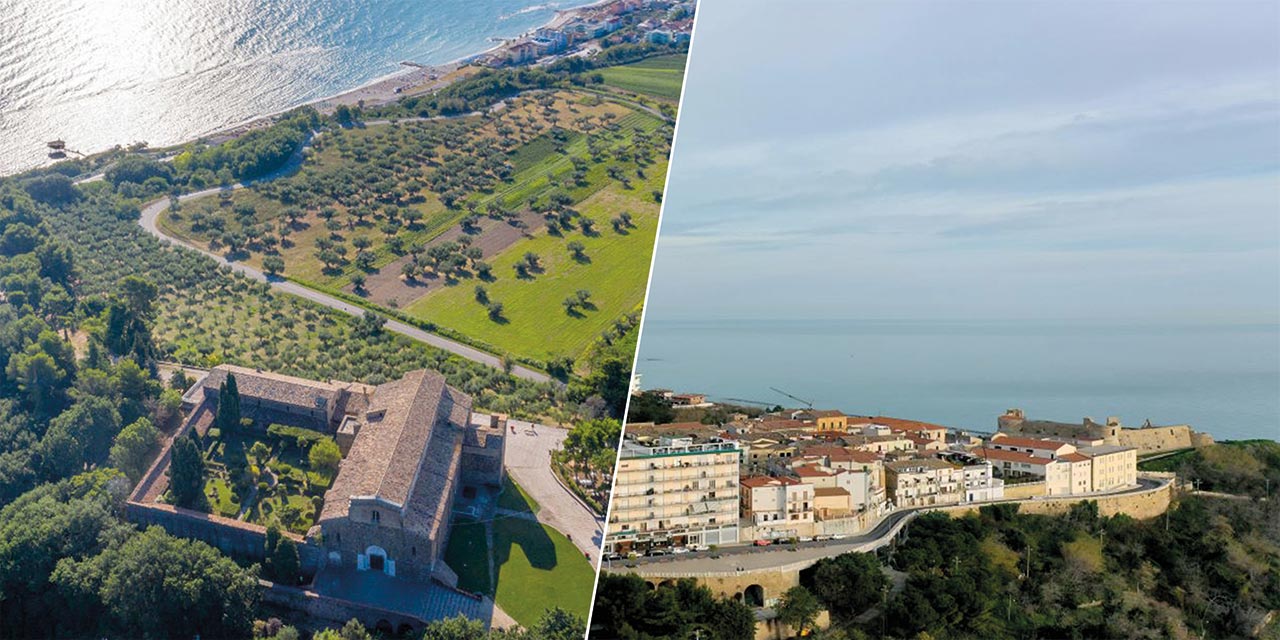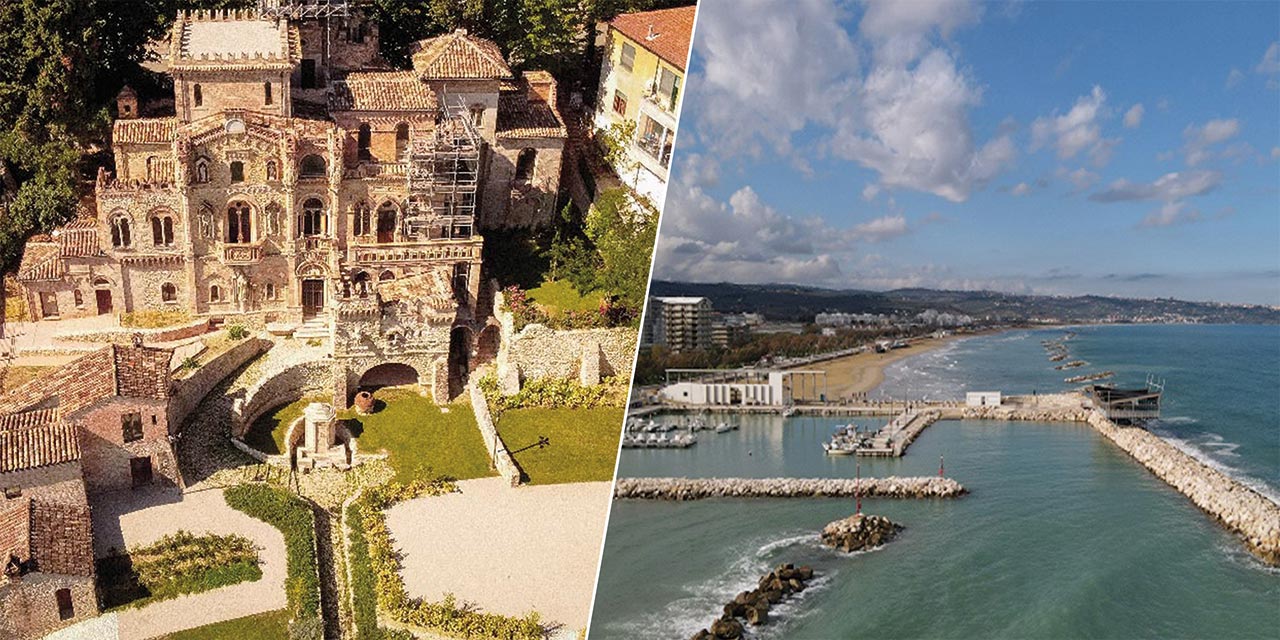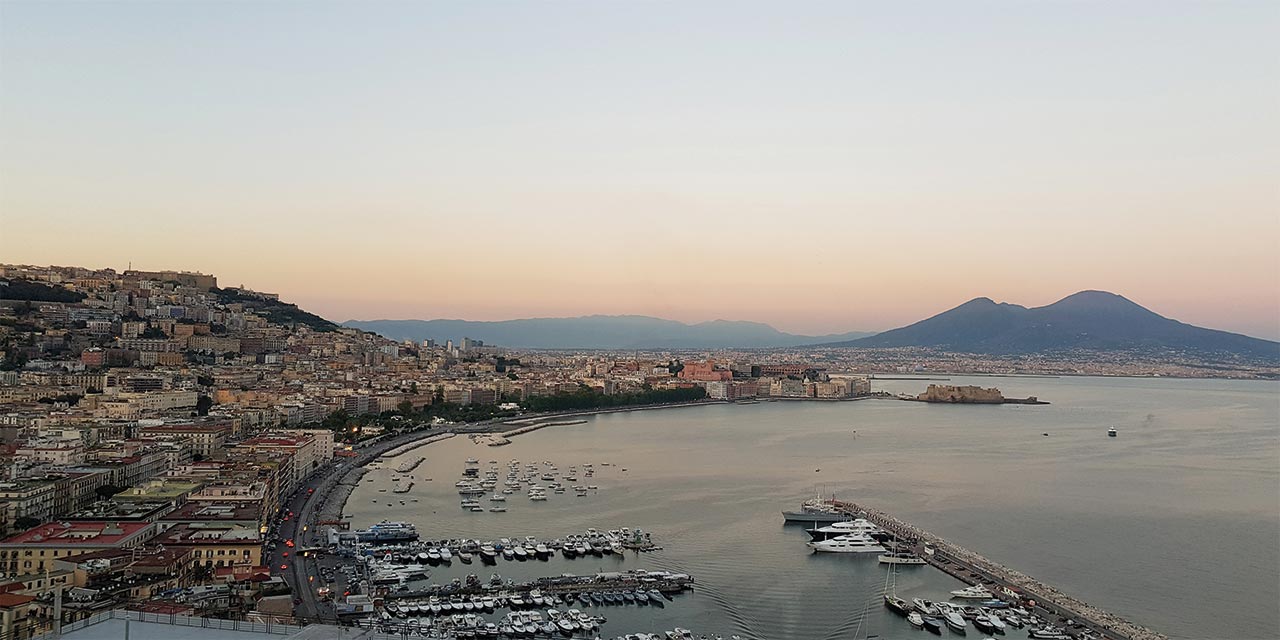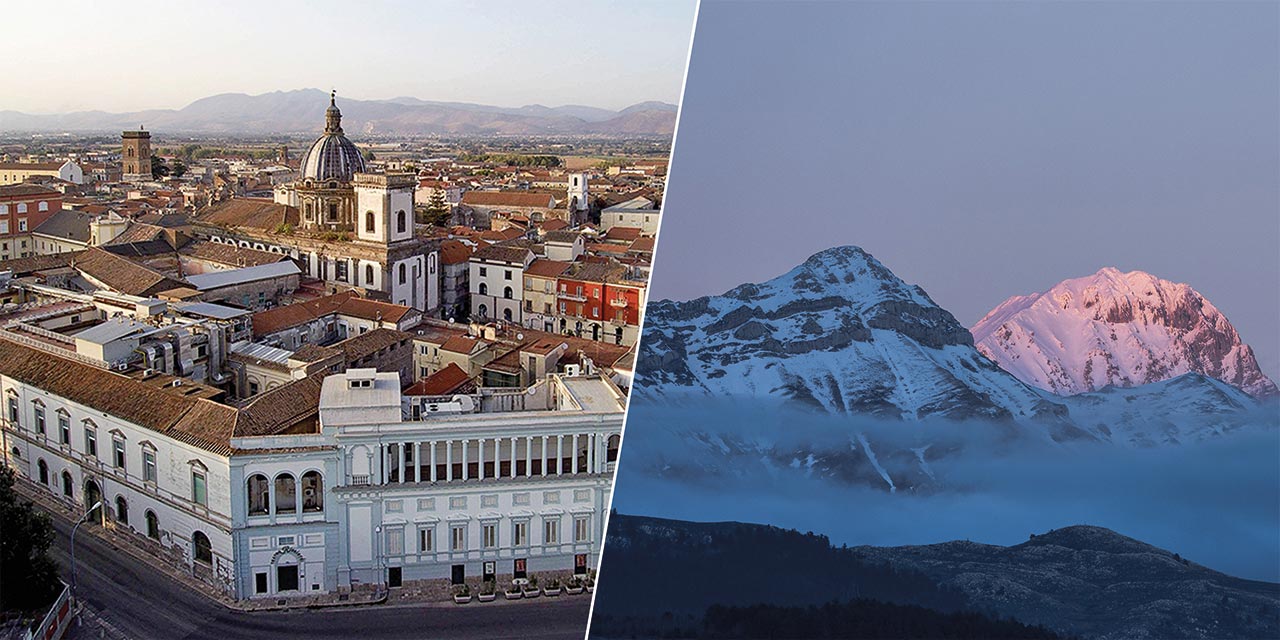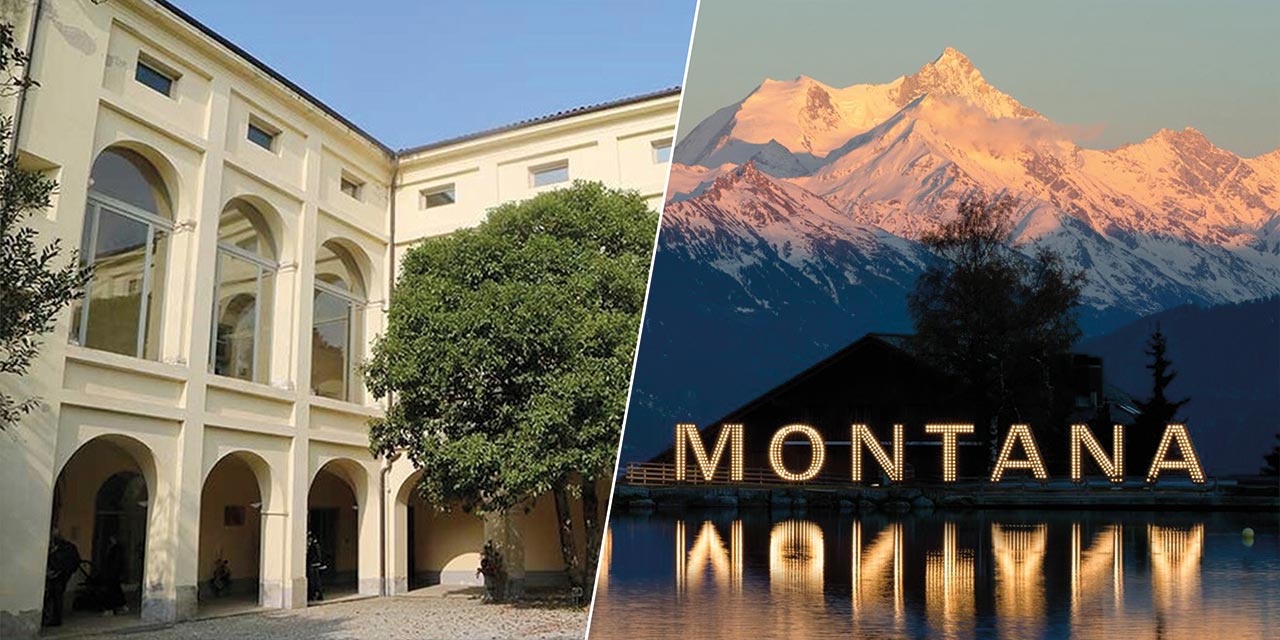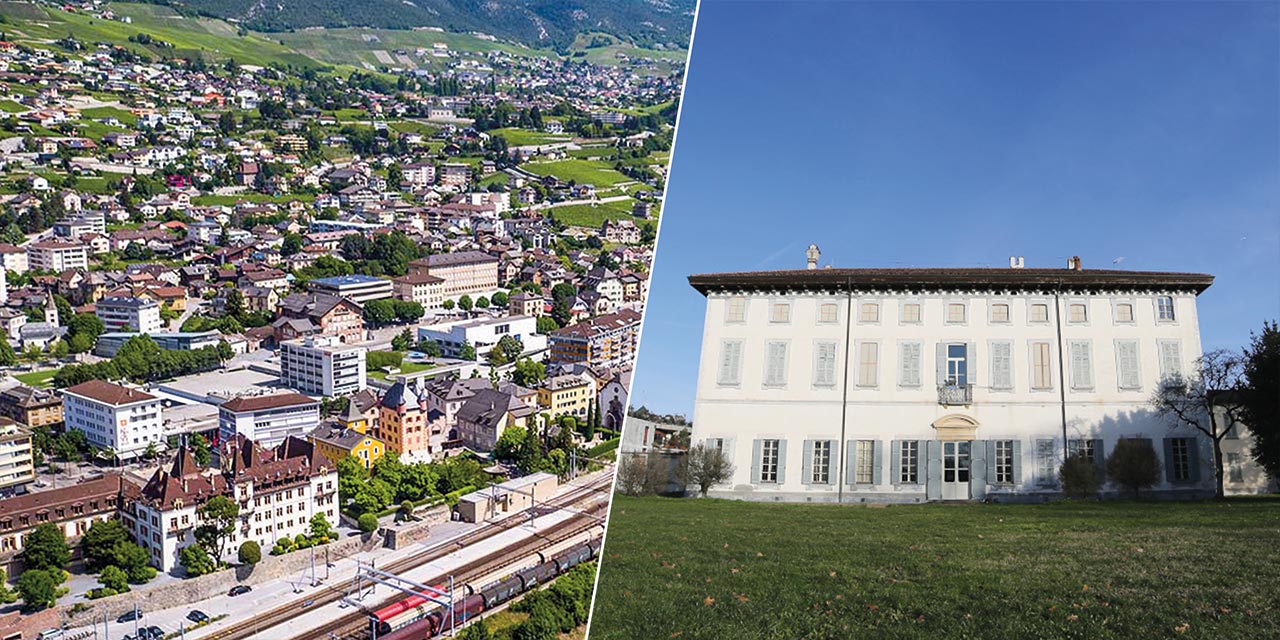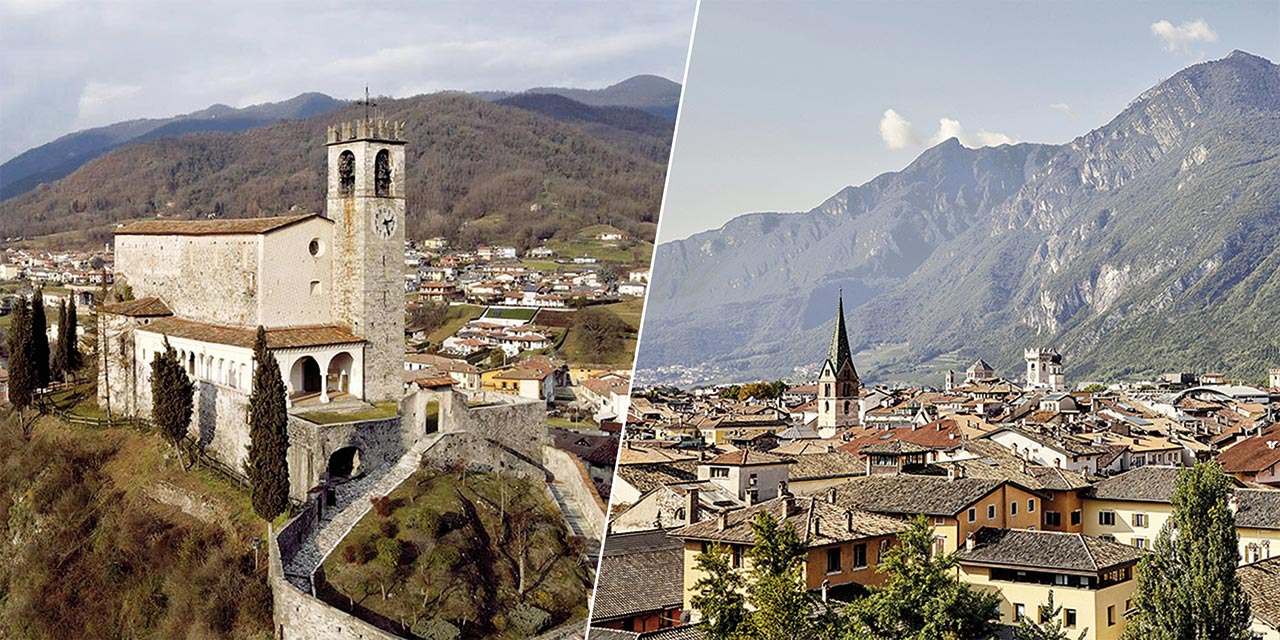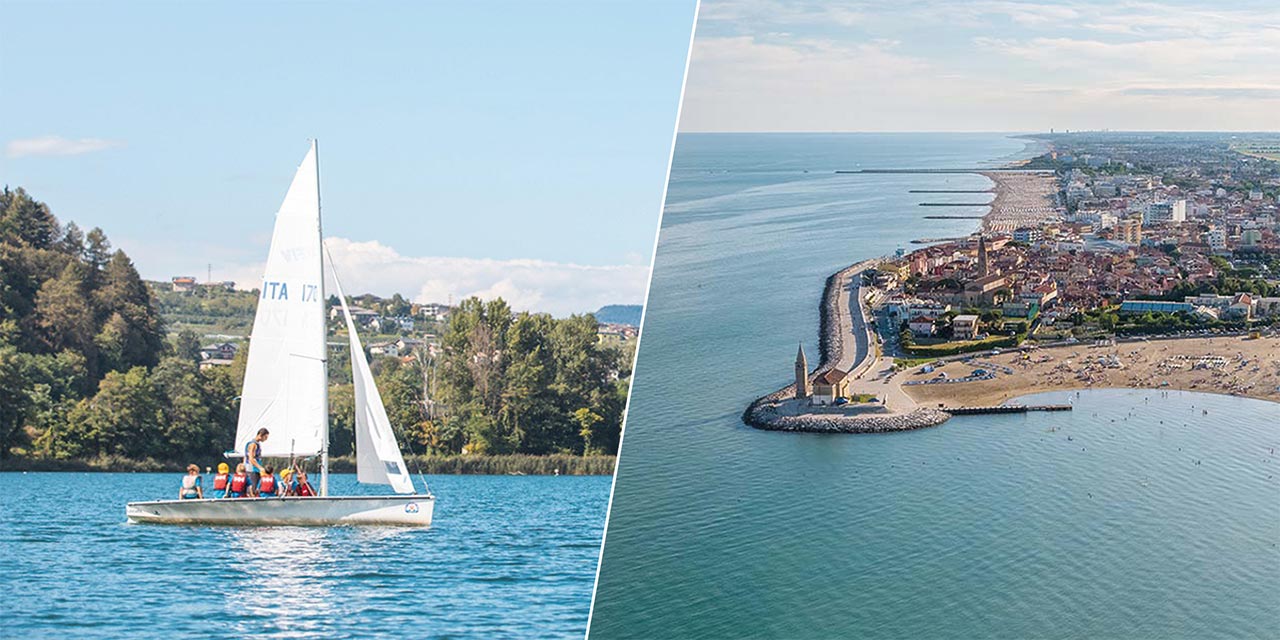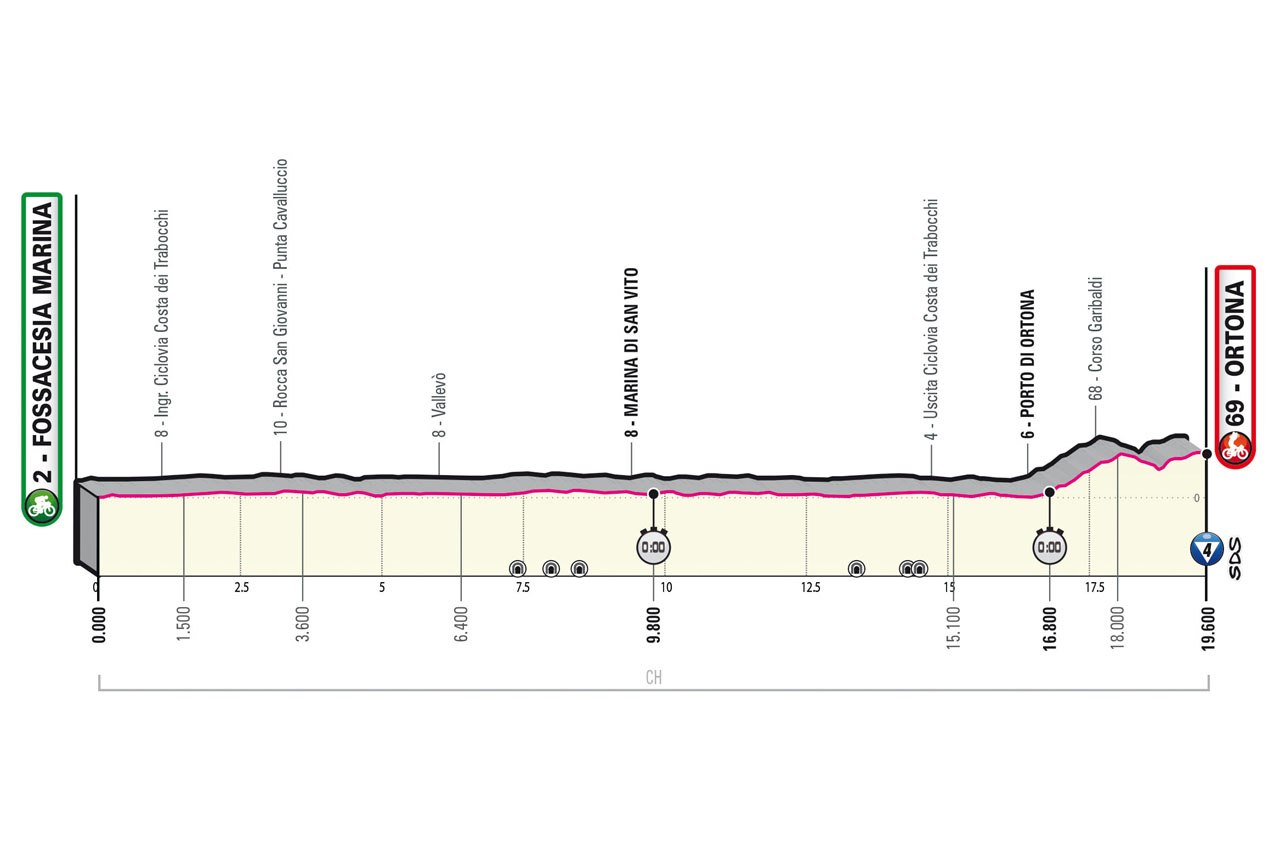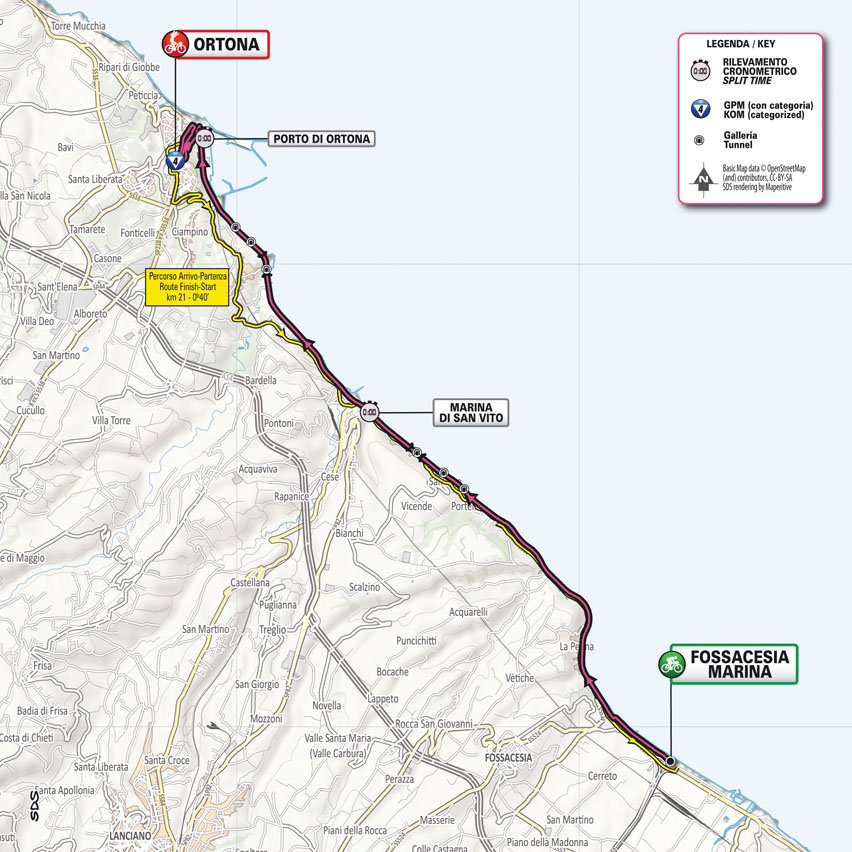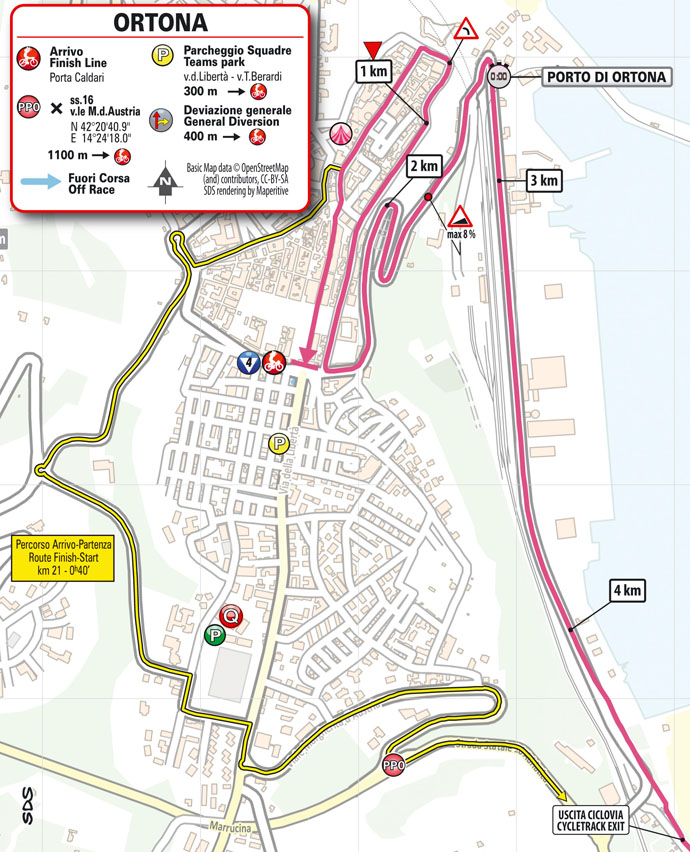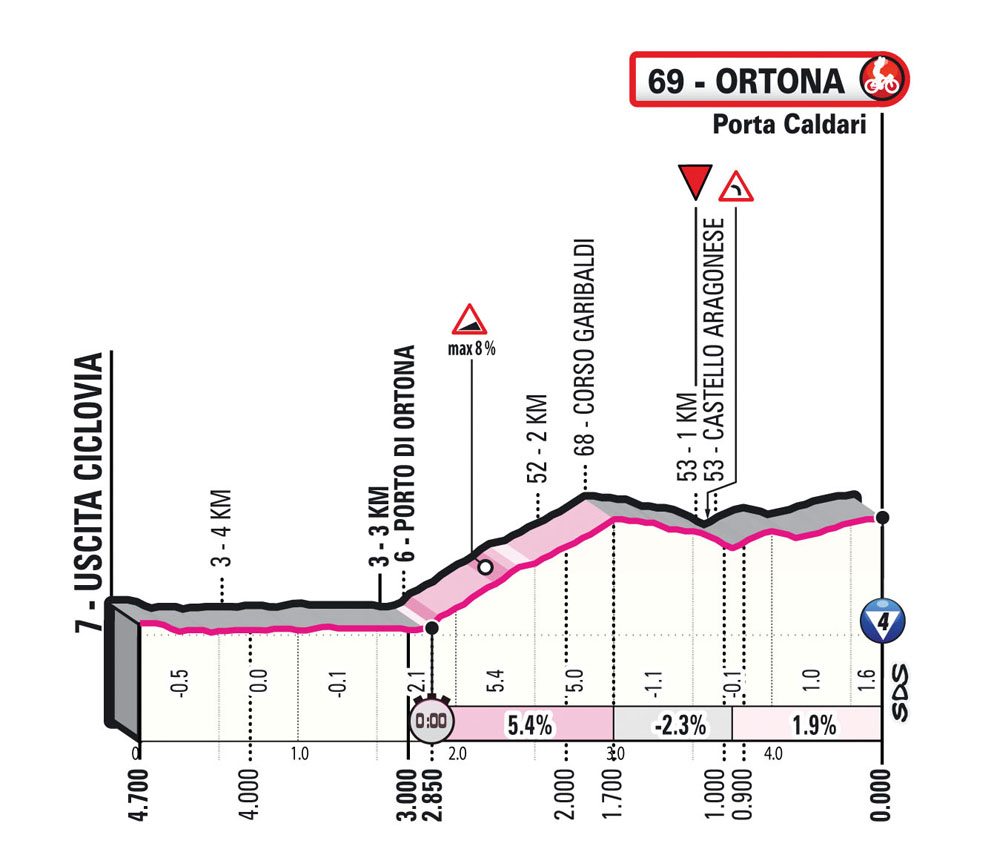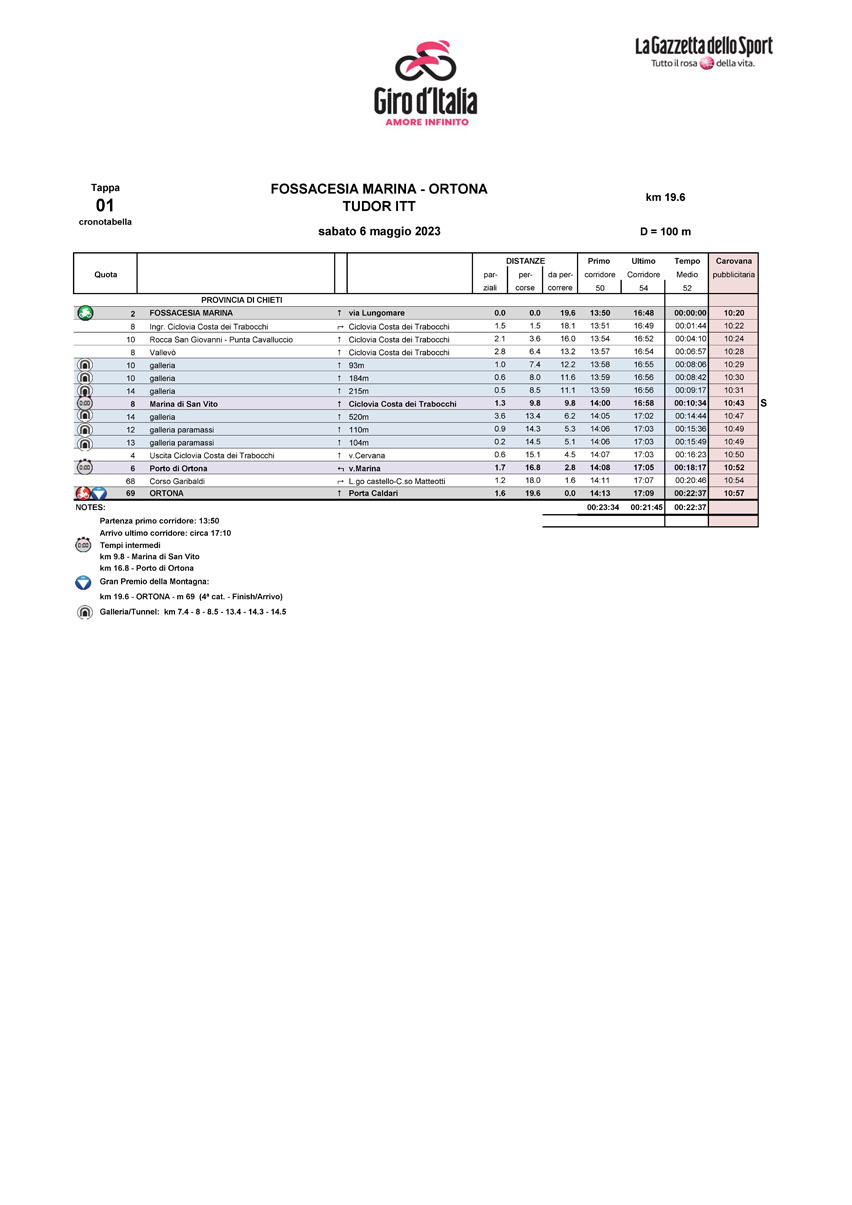profile
map
technical info
The ITT runs flat for approx. 14 km, then ascends slightly all the way to the finish, where KOM points are up for grabs. In the first part, the stage follows the Ciclovia Adriatica, on level and well‑paved roadway, taking in 6 short and well‑lit tunnels along the route. The road narrows slightly when leaving the cycle path. The final climb (approx. 1 km) leading to the urban area of Ortona begins past the second split.
Final kilometres
The route climbs at 5.4% for 1,300 m. After descending gently towards the Castello Aragonese, and plunging to the left, the road goes up again at a mild 2% gradient for the final 750 metres. The home straight (300 m) is on 7 m wide stone‑paved road.
start / finish
final kilometres
itinerary timetable
tourist info
Host city:
Fossacesia Marina
Overview
Set among rows of olive trees, Fossacesia, in the province of Chieti, rises on the hills of Venus, overlooking the Trabocchi Coast. Already inhabited by the Frentans in pre-Roman times, in the Middle Ages Fossa Ceca became a fief of the Benedictine monastery of San Giovanni in Venere, following its alternating historical events.
The current urban plan preserves public buildings and noble villas built from 1600, articulated in areas scattered in the villages Marina and Villa Scorciosa.
The municipal territory extends from the coast, along the river Sangro, up to the look of the mighty bulk of the Maiella. Fertile hills set the table of strong and genuine flavors: DOC and IGT wines; extra virgin olive oil; fruit and vegetables. Hiking, walking or mountain biking trails make the territory stand out. City of Oil and City of Wine, Fossacesia is also Blue Flag for 21 consecutive years, thanks to the excellent waters of its sea.
The coast has pebble and sandy beaches surrounded by rich vegetation characterized by fragrant broom and sea fennel. On the rocks emerging a few meters from the shore, ancient wooden buildings dominate the seabed with plumes and scaffolding, evidence of the ancient local art of fishing while remaining on the shore. These are the trabocchi abruzzesi, platforms welded to the cliff celebrated by D’Annunzio for their mysterious charm and today protected by regional laws as primary cultural heritage.
Fossacesia was awarded in 2007 the Silver Medal for Civil Valor for the contribution paid by the population in World War II, massively bombed in the battles that followed on the Gustav line. By decree of the President of the Italian Republic Giorgio Napolitano in 2007 he obtained the honorary title of City.
Fossacesia has a significant link with cycling: here in fact was the birthplace of the great cyclist Alessandro Fantini, whose vestiges are kept in the city cemetery and whose memory is linked to an imposing statue located in the main square of the city.
Food
The cuisine of Fossacesia is characterized by the attachment of people to their land and the sea and the link with natural products. It is a simple, humble cuisine, which has managed to pass down the most ancient recipes over the centuries.
Located along the Wine Route “Tratturo del Re”, Fossacesia offers its attentive gastronaut Montepulciano d’Abruzzo DOC and other excellent wines from Pecorino, Passerina, Cococciola, but also extra virgin olive oils from the milling of olives Gentile di Chieti, Crognalegno, Intosso and Cucco.
A typical local product is citrus extra virgin olive oil, for whose production the olives are ground directly with lemons or oranges of the Costa dei Trabocchi, to produce an oil with a soft and delicate taste, ideal to enrich every dish of meat and fish. For some years, Fossacesia has been actively engaged in the enhancement of the excellent food and wine of the territory, with the promotion of a tourism dedicated and attentive to local realities.
Many other are the delicacies of Fossacesian cuisine: from pizzas and foje, ancient dish of peasant origin consisting of an unleavened pizza made with corn flour and boiled vegetables cooked in a pan, with extra virgin olive oil, dried peppers and “sardelle”, to “pallotte cace e ove”, egg and cheese meatballs, fried and served in sauce. Typical of the territory, the pizza with peppers and sardines, a dish on the tables of the Fossacesian people on the All-Souls’ Day.
Of the Christmas season are the “crispelle”, or pancakes, from the typical tubular shape, based on flour, potatoes, and water, embellished with raisins and anise seeds, in their sweet version.
Famous for the art of confectionery, among the specialties are the “sise di Venere”, soft pasta cakes stuffed with custard, the “celli pieni”, delicious biscuits made with oil, wine and flour stuffed with grape jam, chocolate, and almonds and bocconotti of Fossacesia, shortcrust pastry, filled with jam, lemon peel, cinnamon, chocolate, and almonds.
Points of Interest
Today Fossacesia embodies the bright reality of a beautiful and prosperous country, several times called “Earth of Venus”, in honor of the goddess Venus Conciliatrice, of which archaeological evidence is still visible.
There are many monuments and historic buildings that enrich this charming town, a small pearl of the Trabocchi Coast.
The Abbey of San Giovanni in Venere stands on the promontory of Venus, a monumental complex of national character. On the area of the present basilica once stood a temple dedicated to Venus Conciliatrice, octagonal and very large, with a large porch with six columns and a solemn staircase. Between 529 and 543 some monks arrived in Fossacesia from the monastery of Montecassino, led by a Father Martino. Probably, he wasn’t a monk of the Order, but a hermit who lived on the Apennines, where there weren’t many testimonies of Christianity. In the name of the fight against pagan cults he wanted the demolition of the temple of Venus and, in its place, the construction of a small Christian church with an adjoining house for the monks. Ruins of the temple, fragments of columns and decorative elements can be seen at the entrance of the cloister on the right side of the basilica. The events of this first monastic nucleus are not very well known: It is only known that the monastery was dependent first of Montecassino, then of Farfa and then became independent in 1004.
Around the year 1000, following the belief of the end of the world, the Christian population made many offerings to churches and convents. The Lombard count Trasmondo I gave San Giovanni many lands and castles, as well as half of the revenues of the underlying port of Venus. His son Trasmondo II made even more remarkable donations and expanded the first Church. The abbot of San Giovanni, Oderisio I, was thus able to enlarge the monastery.
The splendor of the current abbey is due to Abbot Oderisio II the Great, who, from 1165, built the imposing basilica of St. John (50 meters long, 20 wide) and adorned with statues and frescoes both the Church and the crypt below. The Benedictine monks of San Giovanni in Venere soon accepted the Cistercian Rule. In the sixteenth century they replaced the monks of the Order of St. Filippo Neri and in 1610 the Jesuits.
In 1881, the Abbey was declared a “national monument” and assigned to the “Filippini” in custody. The following decades marked its progressive degradation, caused by poor maintenance, some earthquakes and, finally, by the bombings of the Second World War.
Since 1954 it has been the headquarter of the Passionist Fathers, promoters of important maintenance and renovation works.
Today it preserves the monumental facade and the basilica plan with three naves dating back to the extension in Gothic-Cistercian style started in 1165 and completed during the thirteenth century in Gothic – Cistercian style. The facade is characterized by a marble portal of 1230, called the moon, decorated with high reliefs depicting stories of the life of John the Baptist.
In addition to the Benedictine Abbey of San Giovanni in Venere, Fossacesia hosts the ancient church of San Silvestro, in the populous hamlet of Villa Scorciosa dating back to the 11th century.
There are also many historic buildings in the city. These include Palazzo Contini, built in the 18th century, and Palazzo Mayer, built in 1835 by Don Michelangelo Mayer and enlarged in 1852 on the side of Via Polidori. The Palazzo now hosts the Museum of War and Peasant Arts.
Of extraordinary beauty is also the “Palazzo del Parco dei Priori”, an elegant nineteenth-century villa, located in front of the Abbey of San Giovanni in Venere. Restored by the City and open to the public since 2012, now it hosts many artistic and cultural events.
Finally rise in the city center the church of the Rosary of 1876, the old town hall, the parish church of San Donato, whose bell tower dates to the end of 1200 and the Fountain of the five pipes of the end of 1800.
Ortona
Overview
A CITY TO DISCOVER
A land washed by the sea and defended by the Appennine Mountains, Ortona is the gateway to this part of Abruzzo, inhabited since the Bronze Age (1400 BC) as a seafaring and later developed, by the shelter of its promontory overviewing the Adriatic Sea, into a commercial and tourist harbour.
The city now has 24 thousand people living in a hilly area of over 70 sq km – protected to the west by the nearby Mount Majella, 2,793 m in height – extending from south to north along a coastline of about 20 km.
The city was reborn after the tragic destruction of 80% of its buildings from World War II, preserving with affection the important traces of its urban planning and was awarded the Gold Medal of the Presidency of the Italian Republic for the acknowlegement of the civilian contribution of al the victims who sacrificed their lives in honour of their town.
THE COAST AND THE BEACHES OF ORTONA
The coast extends for about 20 km and consists of an initial northern section, location Foro and Lido Riccio, with a wide and sandy beach, free bathing areas and resorts. Of naturalistic interest for its flora and fauna is the beach of dunes that lies between the station of Tollo and the mouth of the Arielli River.
Beyond the sandy lido, there is a succession of coves and pristine gulfs, rich in Mediterranean flora, such as the Ripari di Giobbe, Punto Ferruccio, Punta Lunga and further south Acquabella.
A varied coast, part of the Teatine Coast that extends from Ortona to San Salvo, characterised by the presence of the Trabocchi, ancient fishing structures.
Behind the harbour and the area of pleasure-boating, there is the Lido Saraceni, a sandy bay with beach resorts and free areas below the green promontory of the hill of San Donato.
FESTIVALS AND TRADITIONS
Among the events not to be missed, on January 17 St. Anthony, popular representation of the Saint’s life in various locations around the city and on January 20 St. Sebastian in St. Thomas Square with the ritual of the ferry, a small papier-maché boat full of smoke rockets suspended with a wire that connects the two ends of the square. The voyage of the boat along the thread, once ignited, indicates the auspices for the fishing season and agriculture.
The Good Friday procession during the week of the Easter festivities with the heart-rending singing of the Miserere by the composer Francesco Masciangelo (1823-1906) and the prologue of the procession of symbols of the passion at the crack of dawn. During the first weekend of May, there is the celebration of the Perdono (Forgiveness), in honour of St. Thomas the Apostle, with the Saturday afternoon parade of the silver keys, the Sunday morning procession of the gift and in the evening the procession of the bust of the Patron Saint.
On December 28, a manifestation recalls the end of the Battle of Ortona with the assignment of its award to the distinguished personalities of the community of Ortona.
Food
Abruzzo is among the top 5 regions of Italy for the production of wines and in the countryside of the Province of Chieti, between the Adriatic and the mountain, lies 80% of the region’s vineyards: the diamond point of this territory being Ortona with its orographic structure and rolling hills, rich in rivers and streams, represents the best winemaking of Abruzzo in terms of quality and quantity.
The wines, Montepulciano d’Abruzzo, Trebbiano, Cerasuolo, Pecorino, Passerina and Cococciola, are the expression of this land rich in tradition and innovations.
Besides the various private cellars, there are two wine growers’ cooperatives and a consortium of cooperatives for bottling present on the territory, all internationally acknowledged.
Corvo Palace, in the historic centre of Ortona, hosts the Regional Wine Cellar of Abruzzo, where you can taste and buy a wide variety of local wines. Alongside the winemaking qualities, there is an equally unique and refined production of oil.
BETWEEN SEA AND LAND
The cuisine of Ortona is the happy marriage between the products of the sea and those of the earth. Among the typical dishes you can find the brodetto, fish soup with tomatoes, peppers and EV olive oil, served in terracotta pots; baccalà e patate in umido, salted codfish and potato stew; broccoli e stoccafisso, broccoli and stockfish; baccalà e peperoni, salted codfish and peperoni; seppie e piselli, squid and peas; finally, spaghetti con pelosi o frutti di mare, spaghetti with crab or seafood, and frittura di pesce dell’Adriatico, fried fish of the Adriatic. Tied to the rural tradition is pasta alla chitarra, handmade pasta with mixed meat ragù, cardone in brodo di tacchino, cardoon in turkey soup, pallotte cace e ove, cheese dumplings (made of eggs, grated cheese and breadcrumbs), pizze e fuoije (sautéed mixed greens accompanied by cornbread).
Among the traditional desserts are the nevole, cone-shaped rolled wafers made with mosto cotto, oil and flour, flavoured with cinnamon and baked between two heated iron plates like the pizzelle, a re-elaborated version of the pizzelle of Abruzzo.
Points of interest
The city tour starts from Terravecchia promontory, the hamlet of sailors, overlooking the Adriatic with its quaint narrow streets, the alleyways, the remains of ancient walls built to defend the city and the Aragonese Castle, an imposing defensive building wanted by King Alfonso of Aragon around 1452, after the Venetians had destroyed the port. Built on the ruins of an ancient fortress, with five lateral towers, it was damaged in World War II and in 1946 a landslide caused the collapse of the northern wing.
The ancient Corso Matteotti overlooks Corvo Palace (XVI-XVII centuries). The premises on the ground floor have housed the Enoteca Regionale d’Abruzzo (Regional Winery of Abruzzo); the first floor is the headquarters of the National Tosti Institute with the Musical Museum of Abruzzo. In the museum, through original photographs, letters, score notes, books and furniture that belonged to Francesco Paolo Tosti, you can trace the life of the musician and composer: born in Ortona in 1846 and died in Rome in 1916, he had a prolific output of romanze and chamber music published by Ricordi and lived for over thirty years in London as a singing teacher for the British Royal Family.
Strolling along Corso Matteotti, you can encounter the Cathedral of St. Thomas the Apostle and the homonymous square. From September 6, 1258, it has enshrined the remains of the Apostle Thomas stolen in Chios, Aegean island, by Leon of Ortona during a naval expedition and by the end of the XIV century the temple was referred to as being dedicated to the Patron Saint of the city. The Patron Saint’s Day falls on the first weekend of May, and from Saturday to Monday, visiting the tomb, you can obtain the plenary indulgence of St. Thomas’ forgiveness.
Three chapels of the Cathedral have been destined to the Diocesan Museum, which houses important works of painting, sculpture and jewelery dating from the fifteenth century to the nineteenth century. The church is also the finish line of the Way of the Apostle Thomas, a religious-cultural itinerary of over 450 km that reproposes the value of pilgrimage of the most important spiritual locations of Abruzzo.
After walking through the alleys of the old quarter, you go down the long promenade overviewing the sea, the Orientale, and you reach Farnese Palace, built by the Duchess Margaret of Austria, daughter of Charles V and wife of Ottavio Farnese, when, after the purchase of the city in February 1582, she decided to establish her residence in Ortona. Lady Margaret chose the most picturesque place of the city and the building project was entrusted to the Roman architect Giacomo Della Porta. The Palace is home to the “Basilio and Michele Cascella” Gallery, which exhibits the works of three generations of the famous family of artists.
Continuing along the Orientale, you enter the Terranova hamlet, where you find the “F.P.Tosti” theatre, the cultural heart of the city. It was designed in 1927 and funded by the engineer Tommaso Pincione of Ortona. It was inaugurated in 1930 and for several decades was privately owned.
The square of the Theatre divides it from the Oratorium of the Miraculous Crucifix and of the Sant’Anna complex which houses, on the ground floor, the Public Library, and on the first floor, the MUBA (Museum of the Battle), which exhibits artifacts and documents on the dramatic battles that in December 1943 almost completely destroyed the city with more than 1,300 civilian victims, so as to be called by Winston Churchill, the “little Stalingrad”.
The Terranova hamlet closes the perimeter of the ancient walls at Porta Caldari; Via Constantinople leads upwards to the church of St. Mary of Constantinople, dating from the seventeenth century, while the original building is of the XIII century.
In the Terranova hamlet of St. Francis Square, there is the church of Santa Maria delle Grazie, also rebuilt after the war; guarding the remains of the Blessed Lorenzo of Villamagna, who died in the convent of Ortona in 1535.
On the hill of the San Donato hamlet, four kilometers south from the city centre, on the edge of the Adriatic Speedway 16, stands the Moro River Canadian War Cemetery. There lie the mortal remains of 1,615 soldiers fallen in World War II, belonging to Canadian regiments, who paid the highest toll in the Battle of Ortona.

